 <<<CONTENTS
<<<CONTENTS
O V E R V I E W
THE
STORY OF THE RETREAT OF THE ICE AGE AND THE DEVELOPMENT OF THE
BOAT-ORIENTED HUNTER-GATHERER PEOPLES

Much investigation and discussion exists today about the Ice Age that
covered much of the northern hemisphere around 50,000 years ago. We
also learn about how its retreat, from about 20,000 years ago and
accelerating as it approached 10,000 years ago, and how the glaciers
scraped valleys and how it left behind large glacial lakes. But there
has been very little discussion of how humans responded to the events.
The people closest to the edge of the glaciers were reindeer hunters,
originally found throughout continental Europe and Asia when the tundra
and arctic climate was located in middle latitudes of Eurasia. Even if
there were no glaciers in some places, there was polar cold, and the
land bore no life. As the world climate warmed, the glaciers
began to melt and retreat northward. Where there was land towards
the north, the tundra simply shifted north little by little every year,
and tundra hunters simply shifted with them. But when the climate
became like today, but glaciers still covered Scandinavia. the
northward shift was blocked by both the seas and glaciers. The
reindeer hunters were forced to adapt to the flooded and forested lands
that emerged and then to develop dugout canoes in order to navigate the
landscape. This new way of life matured and the general population
explosion saw the expansion of boat peoples in every direction where
seas, rivers, and marshlands allowed. This is the story of these
events. Creating a very efficient way of life employing boats, these
people found they could now travel some five times faster or farther in
their boats than previously walking on open tundra. Suddenly they could
spread in every direction there were waterways, and furthermore access
the aquatic plants and animals that formerly had been inaccessible
without the boats. This was a very successful way of life, that I
believe has been overlooked and which couild be as significant to
civilization as the development of a farming way of life. The boat
later became the glue that bound the immobile farming civilizations and
settlements together. It gave rise to the Veneti large scale trade
systems, and that of the Phoenicians and Greek-speaking traders in the
Mediterranean. The boat was certainy equal to the developing of a
farming way of life, in the creation of European civilization.
The Ice Age
Glaciers melt,
European reindeer hunters must convert to boat-using hunter- gatherers
in flooded lands
It is well known today, that some 50,000 years ago,
the earth was in the grip of the Ice Age, during which the world
climate was much colder than today, and glaciers accumulated from
origins in mountains, and over millenia descended south covering the
land with ice rivers a kilometer thick, the weight of which depressed
the land below it. In the cold climate in Europe the arctic tunda was
located at the latitude of central Europe. Whle in southern Europe
there were forests and hunters of a large variety of large animals, in
central Europe there were open plains and steppes with herds of horses
and bison, and above that the arctic tundra filled with wholly animals
such as mammoths, but especially reindeer. When many millenia later,
the climate began to warm and the arctic conditions and animals adapted
to it began shifting northward as the glaciers melted and retreated.
Humans, thus shifted with the animals apon which they were
dependent.
Fig 1
Our interest is in the reindeer hunters who shifted
north with the
tundra reindeer. But since the glaciers disappeared more slowly than
the climate warmed, only the tundra reindeer towards Siberia that were
not blocked by the melting glaciers or the meltwaters, were able to
survive. In Europe all the tundras disappeared and reindeer hunters had
to adapt to the new depressed and flooded lands by hunting animals of
wetlands. Since it also became impossible to walk anywhere other than
islands of high land, it was absolutely necessary to develop and become
dependent on boats - dugout canoes - to move any distances. This new
way of life arose first at the most southerly (most blocking) location
of the melting glacier edge, around Denmark, around 12,000 years ago,
and archeology has called this culture the "Maglemose" culture from
being first identified in a bog in Denmark. This culture spread through
the wetlands eastward to what is now the southeast Baltic, and then
north. Gradually reindeer hunters there also had to adapt to the
flooded lands, and also adopted the dugout canoes, except it appears
this version, known as the "Kunda" culture from being first identified
at Kunda, Estonia, had taken to the sea to hunt seals and other aquatic
animals, probably from large dugouts. These were the beginnings of a
new post-glacial way of life, that from archeology, appears to have
been very successful and expanded east as far as the Ural
Mountains.
By 10,500 years ago, the arctic was
inhabitable only by peoples adapted to a flooded landscape (except in
arctic Siberia)
Although humans were smart enough to
devise rafts to cross bodies of water we are not by nature
water-creatures; thus the evolution of a part of humanity into a life
using boats and getting around on water could not have occurred
spontaneously just anywhere. It had to have occurred in a place where
there was no other alternative; where survival depended on it, and the
pressure lasted many generations.
Through
natural selection those groups who devised the best ways of dealing
with the watery environment were the ones who produced the largest
populations and flourished. The following presents the basic
story - including some original discoveries - about the
appearance and expansions of a boat-oriented way
of life that marks an early stage in the evolution of Europe after the
Ice Age.
This side of the European past has never
before been told in full,
because traditionally scholars have focused on the land migrations and
the evolution of
farming and sedentary civilizations particularly in the Indo-European
tradition.
Everyone imagines that European civilization owes
its
existence to farming, but it owes as much to the development of
boat-oriented ways of life as it created the transportation and trade
that tied the civilization together.
Fig 2
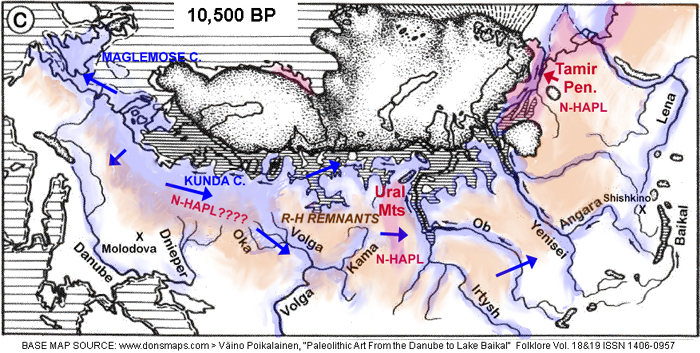
The
blue tone and blue arrows represent the initial expansion of the boat
peoples. The pink tone represents actual surviving reindeer hunters and
herds. The orange tone represents former reindeer hunters left in an
open subarctic landscape who had to hunt other animals like moose and
move around on foot as before. The boat peoples was one of the
adaptations that was very successful. Less successful solutions to the
loss of reindeer herds and the warm climate would have borrowed boat
use, just as later in history, people borrowed farming practices. Once
invented and mastered, anyone could copy. For example, Siberian
reindeer people could copy the new way of life of boat people because
the boat-oriented way of life was invented millenia before reindeer
were threatened towards Siberia - it was available to be copied.
Fig 3
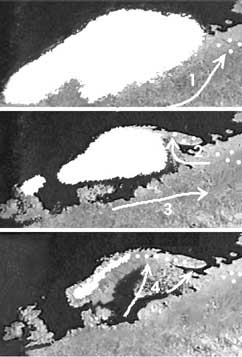
The
expansion of the boat peoples into the arctic is shown in the adjacent
set of maps. It is a very simple set of maps that generally presents
the theory.
1. -
initially reindeer people
migrated north with reindeer. The dots represent reindeer peoples.
However, this European reindeer people way of life may have ended due
to northeast Europe becoming warm and flooded.
2. - 3 Eventually, arctic
Scandinavia is free of glaciers and it is possible for boat peoples to
continue expanding east and for tundra reindeer
to enjoy a refuge in northern Finland and Kola Peninsula. These
reindeer people probably came from descendants of Asian reindeer
people.
4 - The "Kunda Culture" boat people
expands into
the White Sea and the Norwegian
arctic. The best evidence is that it expanded mainly from the Lake
Onega area
1. EASTWARD
TO THE URALS AND BEYOND
Expansion Though
Waterways Eastward to
the Urals, and North to the Arctic Ocean
As one can see when looking at a map showing
the possible
directions of expansion of boat peoples from the Baltic Sea origins,
the basic direction was simply to spread eastward via the Volga or
Dvina Rivers, and by them reach the Ural Mountains. Archeologists have
already seen the spread of boat peoples to the Urals before the 1960's.
The evidence is found on prehistoric banks of lakes and rivers. While
archeologists now give the finds in different rivers, their own names,
usually based on the river names - Volga, Oka, Kama, Ob - they are all
basically the same boat-oriented culture. Located in regions with
trees, and not needing very large boats, their boats would have been
dugouts. The making of a dugout in the old ways was captured on a
Lennart Meri film crew visiting the Hanti peoples of the Ob River.
The map below adds colour to a black and white map
from an archeological paper from
Fig 4
black
and white base map from Kozlowski J, and Bandi H-G 1984
. To understand what this map shows, let
us consider first the "Kunda" culture (1) with the vertical hatching
covering the region from the Baltic as far as Lake Onega. and then,
after a gap, appears again at the Urals, and the source of Dvina,
Pechora an Kama - an ideal location for tribes to meet. (Which suggests
that Kunda people went east on the Dvina to meet with fellow boat
tribes.) These boat peoples were highly mobile, and archeological
findings do not represent any permanent settlements but campsites that
were only used for a couple weeks in annual circulits.
Note the "Maglemose" culture may be the source
of the Volga and Kama cultures, but this map does not cover the south
Baltic and Denmark where they arose. I divide the "Kama" culture zone
in the middle. the green representing the Kama river and the red
representing the Pechora. In general there would have been a tribe in
each river.
The "Kunda" zone near the location where the Pechora
and Kama come together near the Urals suggest. there was a multi-tribe
gathering place at that location where there would have been
socializing and trading.
. How the
"Kunda" culture got there from its main location south of the Gulf of
Finland, is obvous - grouos followed the rivers - the
Sukhona, and then the Dvina to its end near the Urals. Obviously the
black colour hatched areas are based on where archeologists have found
campsites. In
reality, there will be evidence of campsites along the Sukhona and
Dvina between the Kunda hatched area near Lake Onega and the Kunda
hatched area near the Urals. Similarly the gap between Lake Onega and
the White Sea only means boats were in transit.
Because these people were nomadic boat peoples, the
most important information in the map are
the rivers. The north end of the Kama culture is in the Pechora River
basin. Furthermore the headwaters of the Pechora, Dvina, and Kama
are all in the same location - near the midpoint of the Ural Mountains.
Social forces - finding mates, exchainging goods, sharing news -
brought nomadic hunter-gatherers together on a regular basis.
In North
America, families comprising tribes met annually, and one tribe might
be open to hosting neighbouring tribes too. In Canada, among the
Algonqians, the gatherings are now generally called "Pow-wows". It
reflects something
in human social nature since regular, usually annual, gatherings are
found in all peoples everywhere around the world, and the need for
large gatherings still goes in today. (such as the Olympics)
. A correct map should show the Kunda,
Pechora, and Kama cultures are three different archeological cultures
of boat peoples, and there was probably a major gathering place at that
location. It would be there too that contact was made with any
remaining reindeer hunting peoples in the Ural Mountains. This would be
where Asian reindeer people language words entered the language of the
boat peoples.
The archeological information thus proves that the
"Kunda" culture reached both the Urals area, but also the arctic
coasts. A seagoing culture developed first in the Baltic coasts, and it
gave these people the skills to go out onto the sea and hunt large sea
animals like seals, and whales from the White Sea to arctic Norwegian
coast.
My added blue shading shows the true distribution of
activity of the "Kunda" culture, which included bcoming seagoing
peoples, notably whale hunters who circled the arctic ocean.
The trajectory of
the seagoing boat peoples from the Baltic, to Lake Onega, to the White
Sea, and west to the Komsa Culture, is very believable considering that
ways of life tend to continue as it is passed down throught the
generations.
The box below demonstrates that the evidence of the
spread of boat peoples was already evident about 60 years ago in 1952
Fig 5
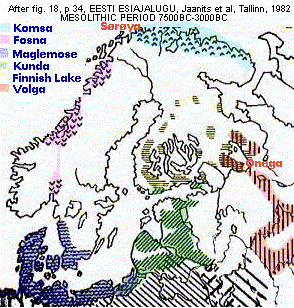
The above map is developed from a learned
text on the archeology of
northern Europe, that depicts assumed archeological groupings based on
locations and/or archeological artifacts. But bear in mind, they
are all fundamentally the same descendants from the original boat
peoples ("Maglemose"). In the expansion of the boat peoples, there were
small adaptations to different environments : The original "Maglemose"
culture was only concerned with travelling around in marshes; the
"Kunda" culture adapted to hunting seals in the sea in large dugouts.
From Lake Onega to the White Sea and arctic Norway the descendants of
the "Kunda" culture did not find large enough trees for seagoing
dugouts, so they developed the skin boat. It is these variations
and different water way locations that inspire archeologists to define
different archeological names. The hatchings to the south, without
colour, are also boat peoples. The inland hunter-gatherers , those
without boats who continued to hunt deer and aurochs, were only found
in the interior highlands to the south of the Oder River Valley (not
shown). As we might expect, the boat peoples went where there was
water, and not in highlands or mountains. Tha means areas that became
populated by boat peoples include the
Oder River, Vistula, and Dneiper water systems, all of which run
through lowlands.
The Divergence of
Boat Cultures in the
Millenia since the original expansion: Archeological manifestations
The concept of the conversion of the glaciers into
flooded post-glacial northern lands, is a very general one. Of special
interest is how archeology reveals humans adapted to the change and
evolved as
tribes in different geographical locations adapted to different
environments, and asserted their territorial rule. As evidence from
archeology shows, there was at
first a rapid expansion, and then as the Ice Age came to an end, and
the environment stablized, so did human populations.
At this early stage, all the
archeological cultures of the boat peoples would have been very similar
in culture
(including language), with only dialectic variation. As the various
bands/clans had settled in annual circuits of travel and
nature-harvesting, they established territories, according to
human nature, and guarded their territories.
Territorial rule is
very significant to all sciences looking at the human past, because it
means
other tribes could not move into occupied territories without a battle
in which the loser is conquered. As a result dynamic equilibriums
developed between neightbouring tribes, interracting with each other
but respecting each other's territories.
Insofar as each tribe
consisted of several clans/bands, the tribe's
territory was the total of the territories of the individual
bands/clans. Because bands/clans associated with each other, they would
have had the same material culture, and therefore there is no question
that each archeologically defined culture of the boat peoples may
represent the territory of only
one
tribe.
The
impact of the arrival of farming
settlement peoples in central on boat peoples: an example from
archeological maps
The sense of territory was defined by the way of life. Conflicts only
occurred if two rival tribes tried to occupy the same territory. That
meant hunter-gatherer tribes would defend their territory against other
hunter-gatherer tribes. However when farming peoples demonstrated they
were not hunting-gathering but growing their own food on farmfields,
there was no sense of territorial conflict. Quite the contrary
hunting-gathering people found farming settlements a curiosity and
visited them to trade. As long as the newcomers did not also trespass
on hunting-gathering sites, they got along.
Fig 7
The
following four maps, developed out
of maps in the same Jaanits et al, source, to generally show how the
descendants of the boat peoples evolved as they interracted with people
pushing north from the south and east
.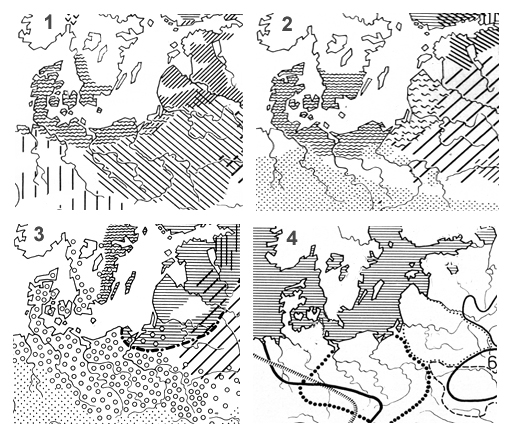
The
above maps do not explain the archeological hatchings in detail. Our
discussion below will be in general to show how things changed
1 - ORIGINAL:EXPANSION
from the map as above, showing how
around 7,000 years ago all the cultures within the area of the map were
Boat Peoples descended from the original reindeer peoples (Ahrensburg
and Swiderian cultures, or the original Magdalenian) These became
the typical northern aboriginal peoples. There were also reindeer
peoples in the arctic. As time went on, civilization was developing in
southeast Europe, producing sedentary settlements and farming. It would
be inevitable that soon the two would interract at their contact
locations.
2 - TWO PEOPLES INTERRACT. The
boat peoples were the aboriginal peoples across northern and
central
Europe. At about 6,000 years ago the settling peoples with some amount
of farming, move north - represented by the screened (dotted) areas,
while at the same time trade has begun between the Kunda Culture and
boat cultures in the rivers reaching south via the Dneiper.
Professional trading has begun
also between the Kunda and Maglemose
cultures, as shown by mixtures of material culture on the east Baltic
coast. (Professional trading means carrying wares from where they are
obtained cheaply to another location where they are valuable, and
making a living from the difference, from the profit.)
3 - EXPANSION OF TRADE
AREAS Since archeology can only find
material culture, the expansion of similar cultures from the south
Scandinavia south towards the Vistula and Oder , and the expansion into
a Comb-Ceramic Culture on the entire east Baltic coast, in effect does
not
distinguish between non-material cultural variations anymore.
Professional trading sells the same goods to all kinds of people with
all kinds of languages and genetics, and so from about 5,000 years
onward it is increasingly difficult to claim parallelism between
language, genetics, and culture, without additional evidence and
analysis.
4 - MATERIAL CULTURE ONLY
SHOWS TRADE PATTERNS. Since archeology
identifies material culture and trade spreads material culture, this
map reflects how it is impossible for scholars to connect the
material culture uncovered with the nature of the people, without much
additional evidence from other sources.. All we can really say is
that professional traders continued to
develop who were energized by north-south trade involving mainly furs
and amber The ancient historic "Eneti", "Veneti" , who history
has associated in particular with the amber trade, arose from this
and lasted until the Roman Empire fragmented and undermined the
original pre-Roman trade systems. From the Roman era onward,
there were various peoples with the "Veneti" name in different parts of
Europe speaking different languages, but incriptions in northern Italy
left by the Veneti/Eneti there from before the Roman era, seem to be
(according to new deciphering work) in a Finnic language, which
makes sense if these people show up strongly in history (ancient texts)
and archeology (findings of dropped amber along the route) as amber
traders originating in the north which by that time (first millenium
BC) appear to have been Finnic.
2.
BRANCHING INTO THE ARCTIC SEAS
Expansion
of the Kunda Culture into the
Arctic Ocean and Beyond
While the "Maglemose" culture has been found from
eastern Britian to the southeast Baltic, and appears to represent a
culture that lived beside lakes and marshes, as one moved north up the
east Baltic coast, the prevailing winds were blowing in from the
northwest and throwing up waves along the coast. To access animals out
from the shore, like seals, it was necessary to develop large dugouts
that could use six rowers and manage the high waves. To hunt sea
animals like seals and whales, it was also necessary to have large
harpoons.
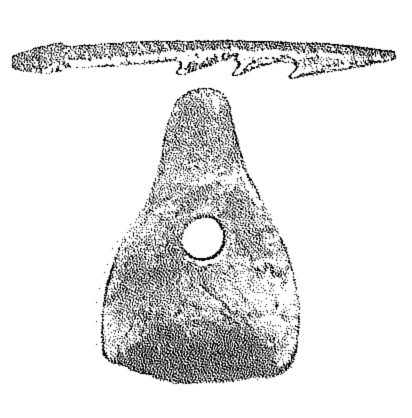
Fig 8
From the "Kunda"
archeological finds, the image at left shows a large harpoon and an
adze head -used for hollowing a log for a dugout with the help of fire.
According to archeology, Kunda artifacts show
origins in the
"Swiderian" reindeer hunter culture before 12,000 years ago, meaning it
did not come from elsewhere. The Kunda, is thus considered a
Post-Swiderian Culture, was a direct consequence of reindeer
hunters in the region of Poland
being forced to abandon reindeer hunting and adapt to living in the
warm flooded lands south of the rapidly melting glaciers.
As figure 2 shows, by about 10,000 years ago, the
world climate was so warm that tundra disappeared completely in
northeast Europe, because of the southward extension of still-remaining
glaciers and glacial seas. As a result all tundra reindeer hunting
disappeared until the glaciers and glacial lakes disappeared perhaps
around 8,000 years ago. The original European origin "Swiderian"
culture reindeer hunters, converted to "Post-Swiderian" hunters -
became the "Kunda" culture.
Northern forest and mountainside individual reindeer
survived, and were hunted by them, along with other animals like moose
and elk, as well as the aquatic life accessible by boat.
That meant that when reindeer returned to the
northeast European arctic, they probably came from Asian reindeer
hunters of arctic Siberia, who had not been blocked by glaciers or
glacial seas. (They would be identifiable in population genetics as
Y-DNA N-haplogroup carriers)
The evidence of
expansion of Kunda boat peoples into the arctic
1.
WHALING
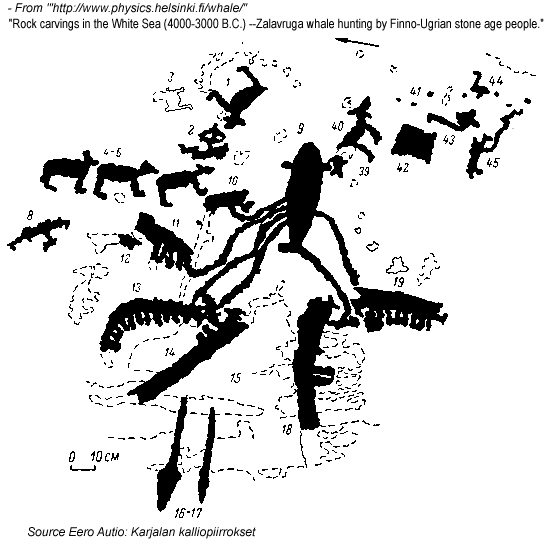
The
above records a rock carving site at
the White Sea. It depicts the world of these oceanic boat peoples -
hunting
moose on land and hunting whales in the sea. The origins of these
peoples at the White Sea is indicated by the boats having moose heads
on the prows. The origins in the Kunda Culture is suggested both by the
fact that Kunda Culture hunted seals and small whales, and that the
moosehead skin boat would have developed because in the arctic trees
were too small to make into dugouts larger than single man canoes.
2.
DUGOUT CANOES, AND THE ADDITION OF SKIN BOATS
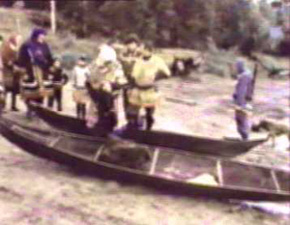
OB
RIVER
The concept of the original boat did not involve
frames and skins.
All boats were dugout logs. The dugout is still made by
the Khanti of
the Ob (image at right is from a Lennart Meri film produced in Estonia
in the 80's) However this dugout is small because at the northern edge
of the forest zone, the trees are too small to make large seaworthy
dugouts.
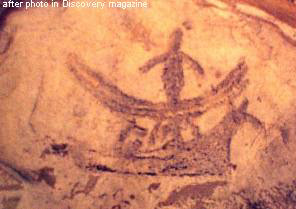 ARCTIC NORWAY
A small dugout like the one of the Hanti (Khanti) is seen in
the
top image
in the rock carving from arctic Norway, dated to some 6000 years ago.
But this small dugout was not adequate for dealing with the high waves
of the ocean, The image below it shows the skin boat made from moose
hide, the moose head represented on the prow.
Boat people who wanted to harvest the
arctic,
therefore could not use
the slim dugouts made from the small northern trees. They had to
develop something new. My theory is that it began with someone's idea
of trying to make a dugout from a dead moose carcass.
ARCTIC NORWAY
A small dugout like the one of the Hanti (Khanti) is seen in
the
top image
in the rock carving from arctic Norway, dated to some 6000 years ago.
But this small dugout was not adequate for dealing with the high waves
of the ocean, The image below it shows the skin boat made from moose
hide, the moose head represented on the prow.
Boat people who wanted to harvest the
arctic,
therefore could not use
the slim dugouts made from the small northern trees. They had to
develop something new. My theory is that it began with someone's idea
of trying to make a dugout from a dead moose carcass.
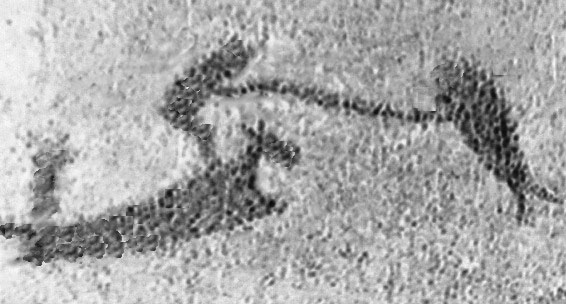 LAKE ONEGA ROCK CARVINGS
The
Lake Onega rock carvings
present several examples showing the
small
moose skin boat being used in sea-hunting. Allowing for some
variation by the artist, the scale of the moose head is
generally of natural size, when compared with the size of the two or
three people inside, suggesting use of a single moose carcass originally
LAKE ONEGA ROCK CARVINGS
The
Lake Onega rock carvings
present several examples showing the
small
moose skin boat being used in sea-hunting. Allowing for some
variation by the artist, the scale of the moose head is
generally of natural size, when compared with the size of the two or
three people inside, suggesting use of a single moose carcass originally
3. THE EVOLUTION OF THE SKIN BOAT'

All
the
skin-on-frame boats of the world owe their origins to this
beginning, which I believe began with applying the concept of the
dugout to a moose carcass. The idea may have begun with someone seeing
a moose swimming and initially thinking it was a large floating log.
Coming close they discover it is a moose; however the idea of making a
large boat was already planted in their mind and they wondered if a
boat could be made from it. In the beginning the idea of a skin on a
frame did not exist. It was born when the concept of the moose's ribs
was employed to hold the skin in shape.
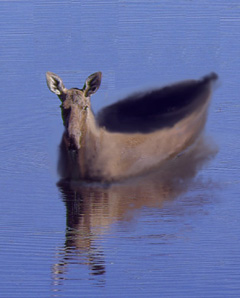 Note that the
moose
Note that the
moose has a massive body giving a great deal of skin that can
be
stretched to create a boat large enough to hold three men.
Since the moose (shown above) is a forest
zone animal, the use of the moose meant that its users did not remain
in the arctic, but migrated between the arctic coast and forested
regions. It is interesting that the Lake Onega carvings show
no images of moose with antlers. Since males grow antlers in summer and
shed them in fall, it follows that the Lake Onega people were in the
Lake Onega area only in winter-spring. They then left for the arctic,
perhaps going as far as Alta, and did not experience the moose with
antlers. The Alta rock carvings also show boats with reindeer heads. It
suggests that those people who DID stay in the arctic, and did not
return south, used the reindeer as a substitute, sewing many skins
together.
The next step was of course the enlarging of this
boat, to hold many
more people. The obvious way to enlarge it was to simply sew skins
together and make it longer. The following images compares a rock
carving of a large boat at Lake Onega, with a typical UMIAK of the
Alaskan Inuit. The umiak shown was made of walrus skins, but it gives
an idea of size. Walrus skin was discovered to be a better
skin than reindeer skim, for those peoples who stayed in the arctic and
did
not descend south in winter to the forested regions where moose were
found.
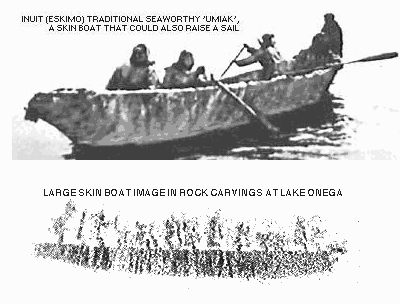
4.
THE SPREAD OF SEAGOING SKIN BOATS WITH ANIMAL HEAD PROWS
The expansion of the Kunda Culture to Lake Onega, White
Sea, arctic
Norway, even British Isles, has plenty of evidence. If we line up the
evidence found in the rock carvings, their dating, and in further
evidence of skin boats where the head of the animal that provided the
skin is honoured on the prow.
Of special interest is the illustration
of the recent Irish Curragh with the animal head, in this case the ox,
is situated on the prow. Also interesting is an illustration of
Greenland Inuit families in whale hunting activity, which is very much
like the illustrations in the White Sea rock carvings, except that the
Greenland Inuit boats lack the head of an animal. This could be
explained if the Greenland Inuit used the skins of whales. Whales have
no proper heads. On the other hand, they say that in the tradition of
Inuit who made their large skin boats, the umiaks, from walrus hide,
the walrus head was at the prow. We can thus trace the expansion of the
seagoing peoples from boats with animal head prows, starting from the
moose heads in rock carvings of Lake Onega, and following rock carvings
of these moose head boats to arctic Norway, and then finding images of
reindeer head boats in Alta rock carvings, the oxhead in the curragh,
the walrus head in arctic Canada, and we could even continue to a
practice of Pacific coast aboriginals with whaling traditions, who
painted whale eyes at the front of their canoes - now dugouts again,
owing to the large trees of the Pacific coast.
Skin boats, with the animal from which the skin came
on the prow
evidently reached the British Isles and the practice continued until
the 18th century - as seen in the following illustration showing an
oxhead on the prow. The heads on the prow became the origins of the
heads on Norse 'dragon boats'
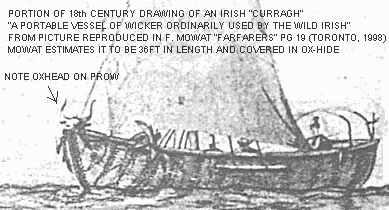
The
head on the prow of boats can
demonstate connections as a result of the expansion of the seagoing
culture. This along with linguistic and cultural evidence will reveal
that these seagoing boat peoples spread around the arctic and even
followed whales southward as early as 5,000 years ago. See the more
detailed pages for more information.
Continuation of
Boat-peoples into the
fur and amber trade leading to "Veneti"
In most of the world, civilization brought the
aboriginal boat peoples to an end with a more efficient way of
procuring food - farming - but the tradition of boats used in the way
of life continued with the fishing and transportation industries.
The earliest application of boat use for
civilization was for long distance trade. When farming took over in
Europe, people became settled and tied to their farmfields and animals.
Since long distance trade was strictly speaking a luxury (the desirable
goods were not entirely necessary) there was no inclination for settled
peoples to invest time and effort to having a separate activity devoted
to carrying on long distance trading activity. especially if people
already skilled and disposed to making boats and travelling long
distances already existed among the boat-oriented seasonally nomadic
boat peoples across the north. Trading with them already existed informally -
farmed goods for wild goods - and so it was easy for some creative
families to see that a living could be made by moving goods from where
they could obtain them for cheap to where they were valuable and make a
living from th difference..
Evidence suggests that there was long distance trade
already about 5000 years ago up and down major rivers like the Danube
and Volga. The strongest evidence lies in Baltic amber ending up in
tombs in Babylon, since amber can survive in the ground and its origins
determined by spectroscopic means. But indirect evidence suggests there
was also a great interest in the south for the thick winter furs of
northern animals.
The professional traders called themselves
descriptively "Venede" which in FInnic mens 'people of the boats', and
the word entered ancient texts as "Veneti" or "Eneti" the initial sound
being unusual - something like WH. Owing to the great demand for amber
in ancient Greece, the "Veneti" became well organized as professional
trader peoples, and successful. When bronze was discovered and it was
made by adding tin to copper, and tin was rare in the ancient southeast
Europe, the "Veneti" began to transport tin from Britain to southeast
Europe. We do not have to guess this. Ancient Greek historian Herodotus
actually wrote around five centuries BC, that tin and amber came to
Greece, brought by 'barbarians' from "the ends of the earth".
It is possible in general that the boat peoples, in
creating long distance trade systems, contributed to the development of
continental European civilization.
Archeology,
Linguistics, vs Genetics
Where possible, I had a look at languages and
genetics to see if they concurred with the reconstruction developed
from the archeological knowledge that has accumulated. Culture (way of
life), language, and genes are not necessarily tied to one another. For
example, today a black African can live in arctic North America and
speak Chinese - showing how all three can be out of parallel. Or
on the opposite extreme, there are also circumstances in which all
three evolve in parallel. Analysis must also address the way the three
facets are parallel or not parallel. For example, when some Asian
reindeer peoples converted to the way of life of boat peoples, they
changed the original genetic makeup of the original boat peoples. They
also had influences on languages closest to the Ural Mountains. The
ancient Venetic language became a trade language, and in the end anyone
who was interested in participating in the world of log distance trade
could join the Venetic trade system, introducing all kinds of genetics;
but to do so they had to learn that way of life and the trade language
that was used.
General
Summary
This project attempts to reconstruct a part of the human
past in
Europe, that has been dismissed as if humans could easily adapt to a
flooded land, after many thousands of years of dealing with sold ground
on foot. While the idea of creating some kind of water craft to cross a
lake or river has always been around - even apes will figure out ways
of crossing a river - the new development was the use of a boat as a
way of life - used daily much like today we use automobiles on
highways. When it had never existed before, the development of the
entire new way of life was not something that could instantly be
created. It had to be touch-and-go trying one thing or another for many
generations. Once the new way of life was mastered, it could then be
easily copied. A new way of life involving boat was not as easy as
hunting peoples deciding to change the animals hunted, and remain
pedestrian hunters on the tundra.
We can agree that it is not easy to develop a new
way of life
involving growing crops, and yet we imagine that we do not need to
develop the new way of life using boats to move through wet
environments they had not had experience before
The above is the basic introductory overview
of the
rise and expansion of boat-using hunter-gatherers when Ice Age reindeer
hunters were forced to abandon their way of life and adapt to a land
below the melting glaciers that was both still depressed from glacier
weight and flooded from its meltwater.
The next chapters/articles go into greater depth
into the developments and some amazing findings.
2018 (c) A. Pääbo.
 <<<CONTENTS
<<<CONTENTS
author: A.Paabo, Box 478,
Apsley, Ont., Canada
2017 (c) A. Pääbo.

 <<<CONTENTS
<<<CONTENTS
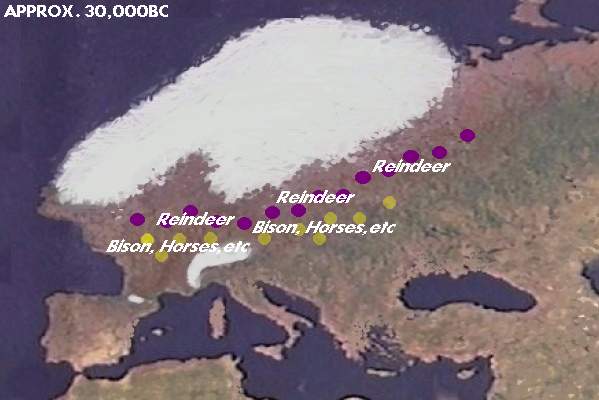
 The
expansion of the boat peoples into the arctic is shown in the adjacent
set of maps. It is a very simple set of maps that generally presents
the theory.
The
expansion of the boat peoples into the arctic is shown in the adjacent
set of maps. It is a very simple set of maps that generally presents
the theory.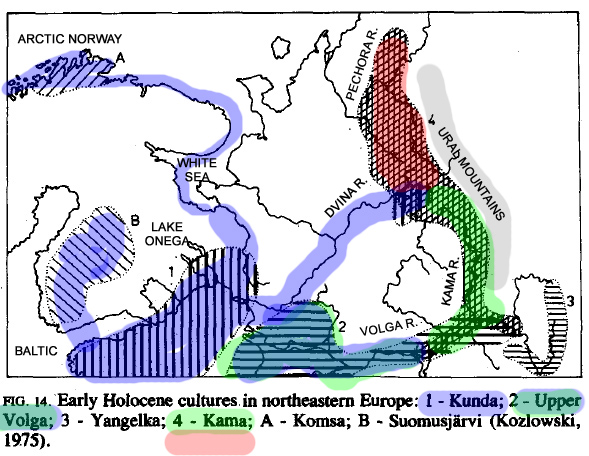










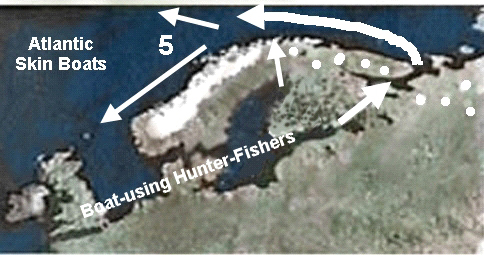

 <<<CONTENTS
<<<CONTENTS